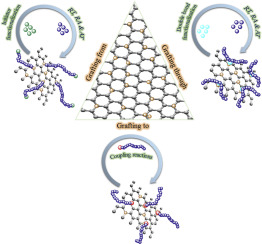Advances in Colloid and Interface Science ( IF 15.9 ) Pub Date : 2019-08-23 , DOI: 10.1016/j.cis.2019.102021 Parvaneh Eskandari , Zahra Abousalman-Rezvani , Hossein Roghani-Mamaqani , Mehdi Salami-Kalajahi , Hanieh Mardani

|
In situ controlled radical polymerization (CRP) is considered as an important approach to graft polymer brushes with controlled grafting density, functionality, and thickness on graphene layers. Polymers are tethered with chain end or through its backbone to the surface or edge of graphene layers with two in situ polymerization methods of “grafting from” and “grafting through” and also a method based on coupling reactions known as “grafting to”. The “grafting from” method relies on the propagation of polymer chains from the surface- or edge-attached initiators. The “grafting through” method is based on incorporation of double bond-modified graphene layers into polymer chains through the propagation reaction. The “grafting to” technique involves attachment of pre-fabricated polymer chains to the graphene substrate. Here, physical and chemical attachment approaches are also considered in polymer-modification of graphene layers. Combination of CRP mechanisms of reversible activation, degenerative (exchange) chain transfer, atom transfer, and reversible chain transfer with various kinds of grafting reactions makes it possible to selectively functionalize graphene layers. The main aim of this review is assessment of the recent advances in the field of preparation of polymer-grafted graphene substrates with well-defined polymers of controlled molecular weight, thickness, and polydispersity index. Study of the opportunities and challenges for the future works in controlling of grafting density, site-selectivity in grafting, and various topologies of the brushes with potential applications in stimuli-responsive surfaces, polymer composites, Pickering emulsions, coating technologies, and sensors is also considered.
中文翻译:

通过受控自由基聚合在石墨烯层上接枝聚合物
原位控制的自由基聚合(CRP)被认为是一种重要的方法,用于在石墨烯层上控制接枝密度,功能和厚度的接枝聚合物刷。使用“从……接枝”和“通过……接枝”这两种原位聚合方法,以及一种基于偶联反应的方法,将聚合物的链端或通过其主链拴接到石墨烯层的表面或边缘,以及称为“接枝到”的方法。“接枝自”方法依赖于表面或边缘连接的引发剂对聚合物链的扩散。“接枝通过”方法基于通过传播反应将双键改性的石墨烯层掺入聚合物链中。“接枝到”技术涉及将预制的聚合物链附着到石墨烯基材上。这里,在石墨烯层的聚合物改性中还考虑了物理和化学连接方法。可逆活化,退化(交换)链转移,原子转移和可逆链转移的CRP机制与各种接枝反应的结合,使得选择性地石墨化石墨烯层成为可能。这篇综述的主要目的是评估制备具有良好定义的,可控制的分子量,厚度和多分散指数的聚合物的聚合物接枝石墨烯基材的最新进展。研究在控制接枝密度,接枝部位选择性以及电刷的各种拓扑结构方面的未来工作的机遇和挑战,这些材料在刺激响应性表面,聚合物复合材料,Pickering乳液,

































 京公网安备 11010802027423号
京公网安备 11010802027423号